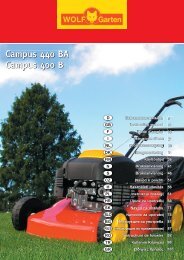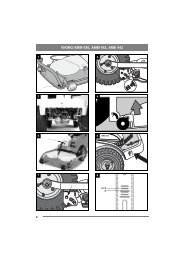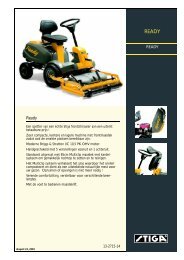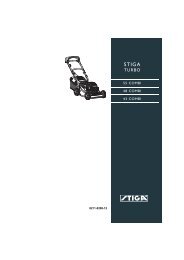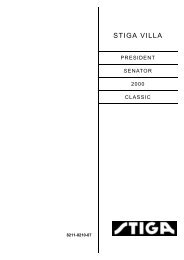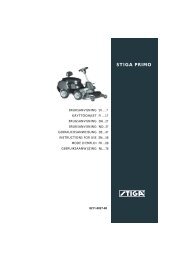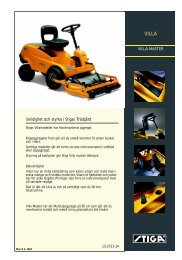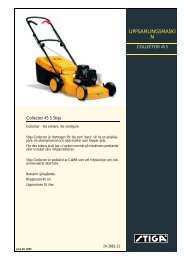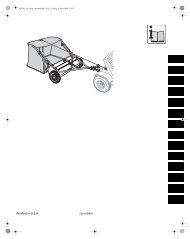Create successful ePaper yourself
Turn your PDF publications into a flip-book with our unique Google optimized e-Paper software.
78<br />
GB<br />
Start position: The electric starter motor is<br />
activated when the key is turned to the<br />
spring-loaded starting position. Once the<br />
engine has started, let the key return to the<br />
operating position.<br />
3.4.12 Cruise control (2:N1)<br />
A switch for activating the cruise control. Cruise<br />
control locks the pedal (1:N) in the depressed position.<br />
1. Press down the pedal until the desired<br />
speed is obtained. Then press the front<br />
part of the switch to activate the cruise<br />
control. The symbol will light up.<br />
2. Disengage the cruise control by releasing the<br />
pedal (1:P) or pressing the rear part of the switch.<br />
3.4.13 Switch (2:G1)<br />
The switch can be used to smoothly set the<br />
cutting height of the cutting deck with<br />
electric cutting height adjustment.<br />
The switch controls the contact (1:G) with<br />
switching polarity.<br />
3.4.14 PTO1 (see fig. 2)<br />
A lever for engaging and disengaging the operation<br />
of the front mounted implement. Two positions:<br />
1. Press the front part of the switch – PTO<br />
engages. The symbol will light up.<br />
2. Press the rear part of the switch – PTO<br />
disengages.<br />
Machines with belt driven PTO:<br />
The control activates a magnetic clutch that transfers<br />
the power from the engine to the PTO pulley<br />
at the pivot point. Only for driving front mounted<br />
accessory.<br />
Machines with hydraulic PTO:<br />
To prevent unnecessary increases in pressure in<br />
the hydraulic system, set the throttle control to<br />
1/4 throttle before the hydraulic PTO is engaged.<br />
The control activates a valve that transfers the<br />
power from the hydraulic pump to the front mounted<br />
implement.<br />
The power is then transferred hydraulically to the<br />
implement via the hydraulic output (1:PTO).<br />
3.4.15 Switch (2:O1)<br />
12V<br />
The switch has three positions and can be<br />
used for the sand spreader for example.<br />
The switch controls the contact (5:O).<br />
3.4.16Switch (2:P1)<br />
The switch has three positions and can be<br />
used for raising and lowering the rear rake<br />
for example.<br />
The switch controls the contact (5:P).<br />
ENGLISH<br />
3.4.17 Hour meter (2:H)<br />
Indicates the number of working hours. Only<br />
works when the engine is running.<br />
3.4.18 Headlight (1:K)<br />
The switch is used to switch the headlight<br />
at the front of the machine on and off.<br />
3.4.19 Disengagement lever (9:U)<br />
A lever for disengaging the variable transmission.<br />
Enables the machine to be moved.<br />
The disengagement lever must never be<br />
between the outer and inner positions.<br />
This overheats and damages the<br />
transmission.<br />
The machine must never be towed but<br />
may only be moved to and from a<br />
trailer, if necessary. Towing damages<br />
the transmission.<br />
The lever has the following two positions:<br />
Lever outwards:<br />
The hydraulic pump is engaged for normal use.<br />
Lever inwards:<br />
The hydraulic oil is connected passed the hydraulic<br />
pump and can flow around the system without the<br />
hydraulic pump blocking the flow. The machine<br />
can be moved. The flow is restricted, however, and<br />
is why relatively large force is required to move<br />
the machine.<br />
3.4.20 Seat (1:J)<br />
The seat is equipped with a safety switch that is<br />
connected to the machine’s safety system. This<br />
means that certain dangerous activities are not possible<br />
when there is nobody sitting on the seat. See<br />
also 5.8.2.<br />
The seat can be adjusted as follows:<br />
Front-rear:<br />
1. Move the control lever (1:A) upwards.<br />
2. Set the seat to the desired position.<br />
3. Release the control lever to lock the seat.<br />
Suspension:<br />
The suspension of the seat can be adjusted according<br />
to body weight using the knob (1:B).<br />
Harder suspension: Turn the knob clockwise.<br />
Softer suspension: Turn the knob anticlockwise.<br />
The suspension setting can be read off from the indicator<br />
by the steering wheel.<br />
Backrest:<br />
The backrest can be adjusted to the desired angle<br />
using the knob (4:Z).<br />
Armrest:<br />
The armrest can be adjusted to the desired height<br />
using the knob under the relevant armrest (1:H).



